The text below is the re-worked text supporting Assignment 2 which was previously posted in on the page 2: One Acre – Final (see Tab at the top of the page) Not quite sure what’s happened but I suddenly feel I understand what I’m supposed to be doing a lot more clearly. In particular it has dawned on me that I’m doing an art degree – not simply a photography qualification.
I’ve not reworked the original supporting text for Assignments 3 and 5 because I’m now incorporating my response to my tutors comments in this blog and incorporating it in the pages above distracts from the final outcome. I feel the final outcome of Assignment 2 deserves similar space.
Why not Assignment 1? Simply because as I noted in a previous post I made a bit of a leap forward between 1 and 2 and don’t think Assignment 1 says anything that could easily stand alone.
Contents Introduction – Display – Images – Lessons Learned – Assessment Criteria - Links Introduction On the face of it this is a very simple assignment – take a dozen photographs of a small area of land exhibiting as great a variety as possible of landscape imagery.
Living on the edge of the Lake District it would be relatively easy to find an acre that offered any permutation of mountains as a backdrop, lakes, waterfalls, woodland and meadows – perhaps even all of them. Too easy in fact – and too impersonal. Instead I have chosen a patch of land much closer to home – a small ‘nature area’ in the
Community Gardens next to my home – a patch of land I regularly visit for a bit of peace and quiet, or to feel alone with the world.
It is almost exactly 1 acre, in a shallow valley surrounded by hedgerow on three sides and some recently developed wildflower areas on the other. It includes a large(-ish) and two small man-made ponds and at the time I originally started this assignment was extremely wet underfoot. Vegetation is largely sedges, grass and the usual collection of nettles and thistles. It is visible as the left hand portion of the central field in the Google maps image below. A ground level panorama taken in early spring is also attached.

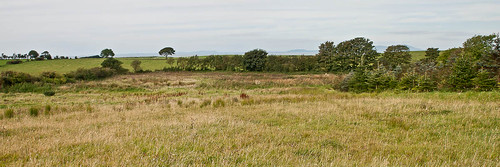
The aerial appears to have been taken a couple of years ago so that the ponds are no longer as clearly defined.
As patches of countryside go it is pretty unremarkable and that, to me, is its attraction. As we have become a more urban population we are led more and more to see the countryside as a spectacle – somewhere to go at the weekend – which means that we need to be entertained while we’re there. Visiting lakes, collecting Wainwrights, cruises, set viewpoints – all seem to me to be symptoms of a separation from the environment around us – and so I want, in this project, to capture something of the reality of my local countryside and why I find this piece of land worth visiting.
In reworking this assignment, and as discussed on my
Learning Log, I have tried to focussed on using collage to construct a ‘place memory’ – an idea I started to investigate
in People and Place. Building on a suggestion from my tutor the final collage incorporates images taken at different times as well as from different locations and perspectives
I took well over two hundred images ranging from multi-shot panoramic views of the site to close-ups of small flowers over a period of several months. The final 12 have been chosen to meet the stated aim of the Assignment (variety of imagery) while allowing me to crop as necessary to develop the final collage.
Display As suggested in the feedback for Assignment 1 I have given some thought to how I might choose to display these images. This has impacted on my choice of images in accordance with my aim to investigate perspective and space memory.
The artist David Hockney has done a lot of work exploring memory and perspective – his joiners are an example of multi-point perspective, and his recent multi-camera work attempts to produce a moving image which is more representative of the way we see.
I made a simple exploration of this, and my understanding of the way memory works in my People and Place blog referenced above. My intent here is to build on this. I envisage the images being displayed either as a single large collage as here, or as individual cropped and mounted images suspended in a 3-D array so that from a distance they appear as the collage image, but closer viewing means the relationship between them varies with viewing position and the individual images are capable of slight movement on the end of their suspension cables. This would give a closer reflection of the way I see my memory of this area working, and would also allow for the overall “memory” to be augmented with new shots.
By contrast with the simple black/orange monotone of my PnP blog post this Assignment requires a greater diversity of images, introducing a broader range of colours and details that have to be selected and assembled to create that ‘place memory’. By displaying them as a large collage the eye is forced to move from place to place and assimilate different scenes and levels of detail so that the brain slowly builds a picture of the overall area in a process which is akin to the way I perceive my memory works.
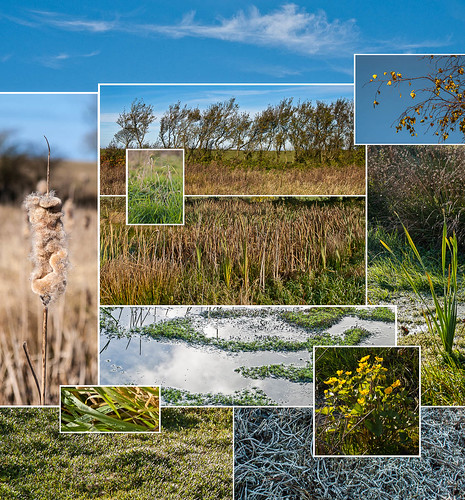 Component Images Figure 1: Blue Sky:
Component Images Figure 1: Blue Sky: These high level clouds, taken in October 2012, feel ideal for the top of the collage: 1/400 @ f/8; ISO 200; 33mm. Slight overexposure to lighten cloud.
 Figure 2: Blue sky with autumn leaves:
Figure 2: Blue sky with autumn leaves: Taken in November 2012. I wanted to introduce some obvious autumn colour, and my original shot suffered from blur, so I have replaced it with this one. 1/500 @ f/9; ISO 400; 50mm – 2/3 stop underexposed to saturate the sky and hold the colour in the birch leaves.
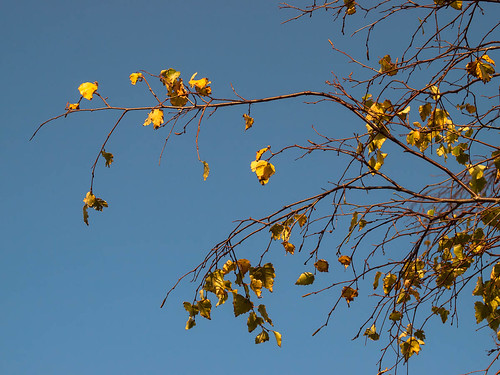 Figure 3: View to western boundary.
Figure 3: View to western boundary. Included to give and edge to the field in the collage. 1/1250 @ f/5: ISO 200; 23mm
 Figure 4: Rush Seed Head.
Figure 4: Rush Seed Head. The bulrush heads disintegrate over the winter period so that by early April they looked like this. Again I had focussing issues – more accurately depth of field issues - with image on the left hand edge of the original collage, so I have replaced it with this one. In any case, this is a more accurate component of the way I visualise the area. 1/2000 @ f/3.5: ISO 100: 54mm. Aperture deliberately chosen to isolate the subject from the similar colours of the background.
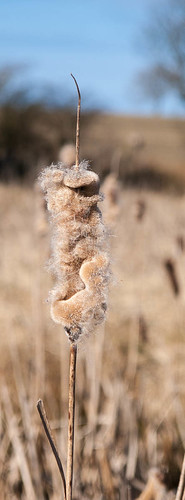 Figure 5: Backlit rush and sedges
Figure 5: Backlit rush and sedges. I felt that a vertical crop of this image would make a good edge shot and the backlighting would add to the variety. 1/100 @ f/9: ISO 100; 50mm
 Figure 6: Grass seedlings.
Figure 6: Grass seedlings. These grass seedlings are already starting to die back as the weather cools down. As with the bulrush seed head shot I used a deliberately small aperture to isolate them from the background. 1/500 @ f/2.8: ISO 200: 50mm
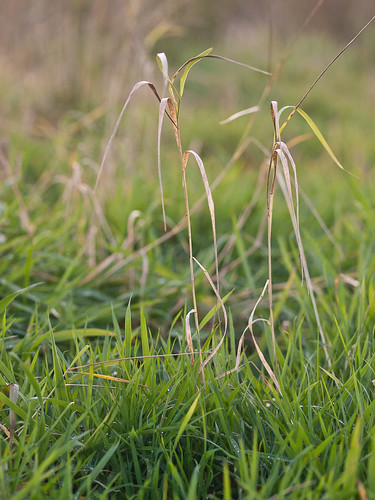 Figure 7: View over rushes
Figure 7: View over rushes. Any attempt to capture this patch of ground needs to emphasise water and marsh plants so rushes are inevitably a central feature of the collage. 1/160 @ f8: ISO 200; 14mm
 Figure 8: Partially submerged marsh plants
Figure 8: Partially submerged marsh plants. These are actually the same plants as Figure 11, but taken after a spell of prolonged rain a few days later. The reflection of the sky helps to link the various parts of the collage together. The ponds are central to the area and this shot is central to the collage. 1/8 @ f/16; ISO 100: 50mm. 1 stop overexposed to brighten clouds.
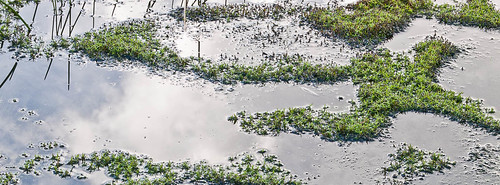 Figure 9: Marsh Marigold
Figure 9: Marsh Marigold A sure sign of late spring early summer in my neck of the woods and one of the reasons this patch of land is special. I make a point of wandering down to see these in flower every year. 1/100 @ f/10: ISO 200: 37mm. Slight underexposure to maintain colour in the backlit flowers
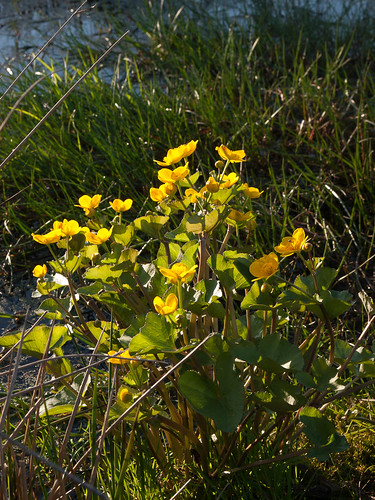 Figure 10: Raindrops on gras
Figure 10: Raindrops on grass. A close-up aiming to capture the raindrops and add to the sense of wetness. This image has bee cropped and rotated for inclusion in the final collage. 1/160 @ f/8; ISO 200; 54mm
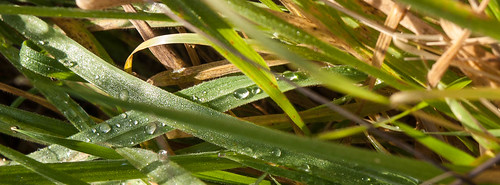 Figure 11: Dew on marsh plants
Figure 11: Dew on marsh plants. Again an attempt to add to the overall feeling of wetness, and to provide a nice damp base to the collage. 1/160 @ f/8; ISO200; 54mm. Slight underexposure to avoid burn out in droplets.
 Figure 12: Frost on marsh plants
Figure 12: Frost on marsh plants Included to highlight another seasonal aspect. 1/25 @ f/8: ISO 100: 17mm
 Lessons learned Concept
Lessons learned Concept: This was quite a challenging exercise once I moved past the simple ‘take some photos of somewhere pretty’ reaction which I think is almost conditioned by the course text. What did I want to do? There were, and are, two lines of research that interest me – one about perspective, space and memory and the other about portrayal of time and seasonal symbolism. Initially I found it hard to resolve which of these to focus on, so initially I simply took some photos to see what emerged. This is perhaps the
key lesson for me – sometimes you have to take photos to help clarify what you are trying to achieve. Does this contradict the lesson of Assignment 1? I don’t think so as I still started shooting with an idea of what I was trying to achieve – it was just not firmly tied down.
The resolution presented in my initial submission was in major part down to the fact that the landscape is so simple that it is almost devoid of seasonal symbolism which, coupled with the time frame for submission, meant an exploration of the portrayal of time was not really feasible in this location. This revised version has the benefit of having been completed over a longer period, so that elements of both time and space have been incorporated into the final presentation.
The other lesson I have learned is that 12 photos is a relatively small selection – it is better to focus them on a single task, rather than trying to portray or explore too may ideas.
Planning: This was the least difficult part of this assignment – at least as far as shooting went. I have continuous easy access to the site. The owners are used to seeing me so, demands of work permitting, I can choose when and what to photograph. Assembling the final collection was somewhat more difficult as I had to sift through the images with an eye to the potential crops I would need for particular parts of the collage. The
key lesson here is that by having an idea of how I wished to present the images I could ensure I had enough options for the final output.
Research: In my blog I have recorded some of the results of my research into studying perspective (albeit in the context of Japanese art in some cases), and into seasonal symbolism in a culture which I perceived – perhaps incorrectly in the light of more recent reading – to be more connected to the seasons than our own. However it is certainly the case that classical Japanese art demonstrates that connection, and the ideas in that art continue to affect the way I look at the world. Some of that may be apparent in this fiunal assignment submission, and will hopefully be apparent in my final portfolio.
On a different note, reading Fox & Caruana during this assignment opened my eyes to the idea
that photography itself can be research and this is one of the first times (if not the first) that I have consciously used it in that way.
Assessment criteria Technical and Visual Skills: Once again
I find this difficult to assess. I think I have produced a range of images from close-up to distant landscape, of a range of subject matter, in a technically competent way. I made much more use of a tripod in these images and I believe these samples show that I can produce technically sound images. I’m still not sure I fully understand what is meant by visual skills but I believe I have avoided a simple pictorial approach – I have tried to be honest about the area itself – and I belive that in developing a collage for final assessment I have demonstrated that I an see beyond the edge of a single image.
Quality of Outcome: Given that the aim of the assignment (beyond the stated one) was to explore memory – the recollection and portrayal of space and time - I believe this is a good start in an area of study which I expect to revisit in the future.
Creativity: In looking beyond traditional flat presentation of a set of images I believe I have taken a creative approach to addressing one of the limitations (in a purely physical sense) of photography in producing a sense of place. It is certainly the first time that I have considered displaying photographs as an installation that allows physical interaction with the viewer.
Context: I have tried to place this assignment into the context of some current thoughts on portrayal of perspective and the workings of memory. In doing so I have gone outside simple photographic literature by picking up on the work of David Hockney alongside more conventional photographic practice. I have also drawn on Japanese landscape tradition and their inclusion of multiple seasons in single images.
Links and references Land Matters: Liz Wells – recommended course text which emphasises the potential of Landscape to convey messages.
A Bigger Message: Conversations with David Hockney: Martin Gayford – a series of interviews/recollections of conversation with David Hockney
Behind the Image: Anna Fox and Natasha Caruana – recommended course text on research in photography
World Kigo Database – a database of seasonal words for Haiku writers that provides a lot of inspiration for seasonal imagery.
Japan Season by Season: Sandrine Bailey


















